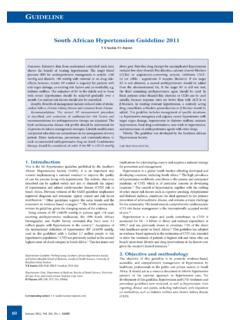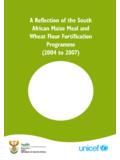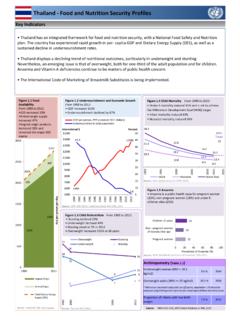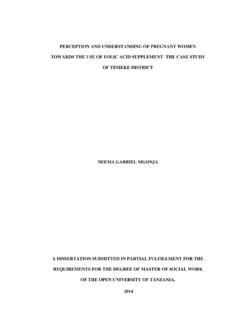Transcription of THE STATE OF FOOD SECURITY AND NUTRITION …
1 This year s edition of T he STATE of food SECURITY and NUTRITION in the World mon itors progress towards ensuring access to food for all (UN Sustainable Development Goal [SDG] Target ), and putting an end to all forms of malnutrition (SDG Target ). For the first time, this year s report provides two measures of food insecurity. FAO s traditional indicator of the extent of hunger, the prevalence of undernourishment, is complemented by the prevalence of severe food insecurity, which is estimated based on data collected from adult individuals worldwide using the food Insecurity Experience Scale (FIES). The FIES is a new tool to measure people s ability to access food , based on direct interviews. In addition, the report assesses the trends for six NUTRITION indicators: anaemia in women of reproductive age, stunting, wasting, overweight, obesity and levels of exclusive breastfeeding.
2 Given its enhanced scope, the traditional partnership of FAO, IFAD and WFP in preparing Building resilience for peace and food security2017 THE STATE OF food SECURITY AND NUTRITION IN THE WORLD4005006007008009001 00010111213141516 Prevalence of undernourishment (left axis)Number of people undernourished (right axis) : Prevalence and number of undernourished people in the world, 2000 2016. Figures for 2016 are projected : NUMBER OF UNDERNOURISHED PEOPLE HAS BEEN ON THE RISE SINCE 2014, REACHING AN ESTIMATED 815 MILLION IN 2016this report has been expanded to bring in the knowledge and expertise of UNICEF and WHO as n 2016, the number of undernourished people in the world increased to an estimated 815 million, up from 777 million in 2015 but still down from about 900 million in the year 2000. This sobering news comes in a year in which famine was declared in one country and crisis-level food insecurity situations at risk of turning into famines were identified in several others.
3 The food SECURITY situation has visibly worsened in parts of sub-Saharan Africa and September 2017 ISBN 978-92-5-109888-2128 297 mmAlso available in:Arabic, Chinese, French, Russian and SpanishSubject categories: food securityNutritionResilience buildingConflictClimate changeThe STATE of food SECURITY and NUTRITION in the World is an annual flagship report jointly prepared by FAO, IFAD, UNICEF, WFP and WHO to inform on progress towards ending hunger, achieving food SECURITY and improving NUTRITION and to provide in-depth analysis on key challenges for achieving this goal in the context of the 2030 Agenda for Sustainable Development. The report targets a wide audience, including policy-makers, international organizations, academic institutions and the general The 2030 Agenda for Sustainable Development and the UN Decade of Action on NUTRITION 2016 2025 call on all countries and stakeholders to act together to end hunger and prevent all forms of malnutrition by 2030.
4 This year s edition of The STATE of food SECURITY and NUTRITION in the World marks the beginning of a regular monitoring of progress towards achieving the food SECURITY and NUTRITION targets set by the 2030 Agenda. In 2016 the number of chronically undernourished people in the world is estimated to have increased to 815 million, up from 777 million in 2015 although still down from about 900 million in 2000. After a prolonged decline, this recent increase could signal a reversal of trends. The food SECURITY situation has worsened in particular in parts of sub-Saharan Africa, South-Eastern Asia and Western Asia, and deteriorations have been observed most notably in situations of conflict and conflict combined with droughts or floods. The apparent halt to declining hunger numbers is not yet reflected in the prevalence of child stunting, which continues to fall, though the pace of improvement is slower in some regions.
5 Globally, the prevalence of stunting fell from percent to percent between 2005 and 2016, although 155 million children under five years of age across the world still suffer from stunted growth. Wasting affected one in twelve (52 million) of all children under five years of age in 2016, more than half of whom ( million) live in Southern Asia. Multiple forms of malnutrition coexist, with countries experiencing simultaneously high rates of child undernutrition, anaemia among women, and adult obesity. Rising rates of overweight and obesity add to these concerns. Childhood overweight and obesity are increasing in most regions, and in all regions for adults. In 2016, 41 million children under five years of age were overweight. The number of conflicts is also on the rise. Exacerbated by climate-related shocks, conflicts seriously affect food SECURITY and are a cause of much of the recent increase in food insecurity.
6 Conflict is a key driver of situations of severe food crisis and recently re-emerged famines, while hunger and undernutrition are significantly worse where conflicts are prolonged and institutional capacities weak. Addressing food insecurity and malnutrition in conflict-affected situations cannot be business as usual . It requires a conflict-sensitive approach that aligns actions for immediate humanitarian assistance, long-term development and sustaining peace. This report sends a clear warning signal that the ambition of a world without hunger and malnutrition by 2030 will be challenging achieving it will require renewed efforts through new ways of working. South-Eastern and Western Asia. Deteriorations have been observed most notably in situations of conflict, often compounded by droughts or floods (linked in part to the El Ni o phenomenon).
7 Conflict is an increasingly important cause of food insecurity and malnutrition. In 2016 alone, the far-reaching effects of violent conflict and civil insecurity left more than 63 million people in 13 countries facing severe levels of acute food insecurity and in need of urgent humanitarian assistance. Conflict and violence have led to the displacement of millions of people, causing and protracting food insecurity in host communities. The number of displaced people worldwide is at an all-time high, as war and persecution continue to rise. Currently, one in every 113 people is now either a refugee, internally displaced, or seeking asylum. P roblems of acute food insecurity and malnutrition tend to be magnified where natural hazards such as droughts and floods compound the consequences of conflicts. The concurrence of conflict and climate-related natural disasters is likely to increase with climate change, as climate change not only magnifies problems of food insecurity and NUTRITION , but can also contribute to a further downward spiral into conflict, protracted crisis and continued he 2030 Agenda makes an explicit link between sustainable development and peace and calls for a transformative approach, with improved collaboration on conflict prevention, mitigation, resolution and recovery.
8 NKEY MESSAGES Download full text her














